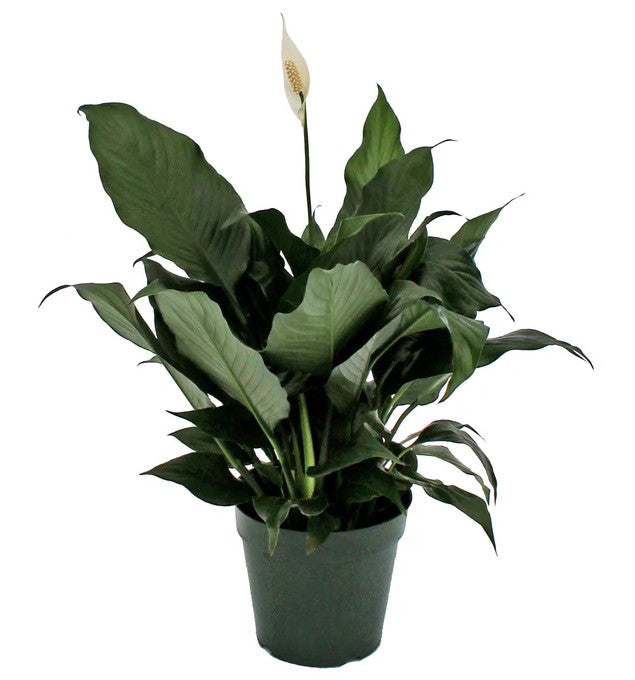SoCal Soul Plants & Gifts
Peace Lily 6"
Peace Lily 6"
Couldn't load pickup availability
Light:
• Peace lilies prefer low to medium indirect light. They can tolerate low light but produce more blooms with brighter, indirect light.
• Avoid direct sunlight, as it can scorch the leaves and cause browning.
• A spot near a north or east-facing window is ideal. In lower light, the plant will still thrive but may bloom less frequently.
Watering:
• Peace lilies like their soil to be consistently moist, but not soggy. Water the plant when the top inch of soil feels dry.
• Thoroughly water, allowing excess water to drain out of the pot. Ensure the plant isn’t sitting in water, as peace lilies are prone to root rot.
• These plants are quite good at signaling when they need water—if the leaves start to droop, it’s time to water.
Humidity:
• Peace lilies thrive in high humidity. If the air is too dry, the tips of the leaves may turn brown.
• You can increase humidity by misting the plant regularly, using a humidity tray, or placing it near a humidifier, especially in dry indoor environments.
Temperature:
• Peace lilies prefer temperatures between 65°F and 85°F.
• Avoid exposing the plant to temperatures below 55°F or to cold drafts, as this can damage the leaves.
Soil:
• Use a well-draining, peat-based potting mix. A general houseplant soil mix works well, but you can also add perlite or sand to improve drainage.
• Ensure the pot has drainage holes to prevent waterlogging.
Fertilizer:
• Feed the plant with a balanced, water-soluble fertilizer diluted to half strength every 4-6 weeks during the growing season (spring and summer).
• Avoid over-fertilizing, as peace lilies are sensitive to salt buildup in the soil. Too much fertilizer can lead to brown leaf tips.
• Do not fertilize in the fall and winter when the plant’s growth slows down.
Pruning:
• Remove any yellow or brown leaves to keep the plant healthy and looking its best.
• Cut off spent blooms at the base to encourage new flowers and prevent the plant from using energy on dead blooms.
Repotting:
• Peace lilies typically need to be repotted every 1-2 years when they become root-bound. You’ll know it’s time if you see roots growing out of the drainage holes.
• Repot in the spring, using fresh soil and a pot that is only slightly larger than the previous one.
Pest Control:
• Peace lilies are relatively pest-resistant, but they can sometimes attract pests like spider mites, aphids, or mealybugs.
• Regularly inspect the leaves for pests and wipe them down with a damp cloth. If an infestation occurs, treat with insecticidal soap or neem oil.
Flowering:
• Peace lilies produce white blooms, known as spathes, which appear sporadically throughout the year.
• Blooms typically last for several weeks, after which they turn green and eventually brown. Once a flower has faded, trim it off at the base to encourage new blooms.
Toxicity:
• Peace lilies are toxic to pets and humans if ingested, so keep them out of reach of small children and pets.
Common Issues:
• Drooping leaves: This is often a sign of underwatering. Water the plant, and it should perk up within a few hours.
• Brown leaf tips: Can indicate low humidity, over-fertilization, or inconsistent watering. Increase humidity and check your watering and fertilization routines.
• Yellowing leaves: This can be caused by overwatering or insufficient light. Adjust your care routine accordingly
Care Instructions
Care Instructions
Delivery only available in IL & MO
Delivery only available in IL & MO
Currently, shipping is only available to Illinois and Missouri addresses.
In-Store Pick Up
In-Store Pick Up
Free in-store pick-up is available during store hours. Orders are ready to go within 24-48 hours after your order is placed.
Additional Info
Additional Info
Each plant is unique; size, coloring, and shape fluctuate so your plant may be slightly different than the one pictured. However, you'll always receive a happy healthy plant hand-picked, and I won't give customers anything I wouldn't take home myself!
Share


